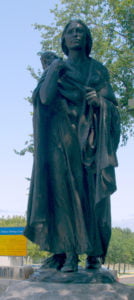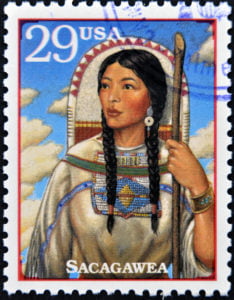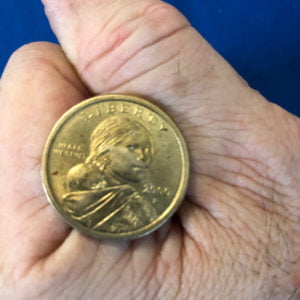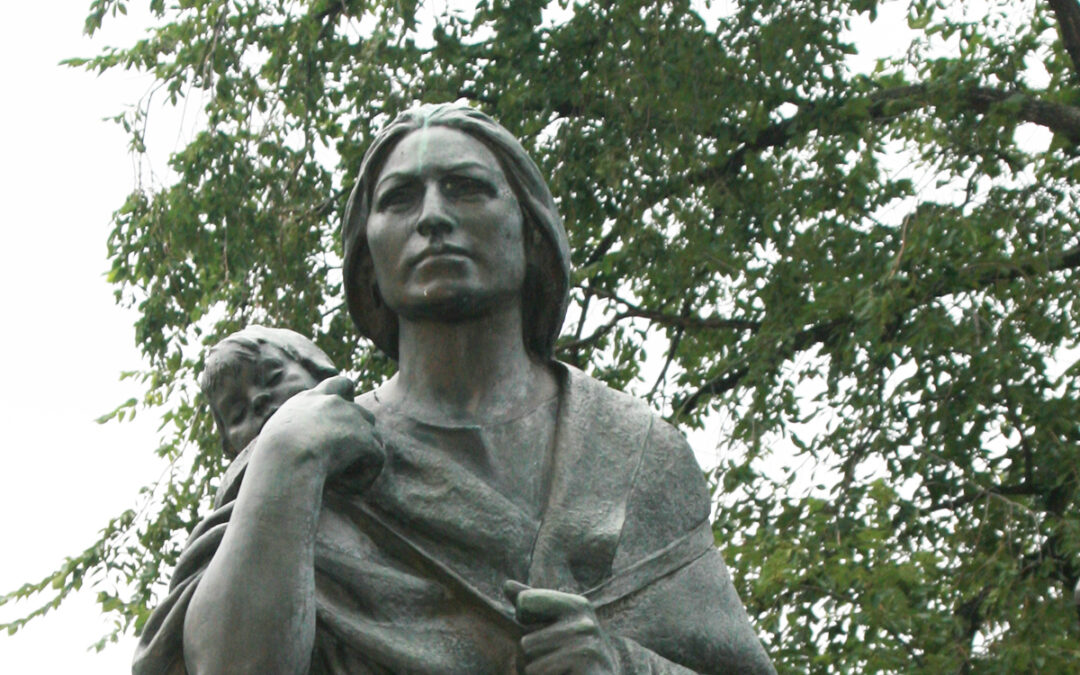Just when you think you know something, new information proves you wrong!
Bulls Eye, the grandson of Sacagawea, stated: “We have heard about some white men who wrote about my grandmother. These white men came along here about a hundred years ago. They made a mistake.”
 “Our Story of Eagle Woman: Sacagawea, They Got it Wrong,” a new book, looks at the misinformation about the only woman who accompanied the Lewis and Clark Expedition.
“Our Story of Eagle Woman: Sacagawea, They Got it Wrong,” a new book, looks at the misinformation about the only woman who accompanied the Lewis and Clark Expedition.
While new to me, the stories in it are actually old, so I took down my erroneous blog from 2019 and rewrote this one entirely.
I came upon this book a year ago while visiting Like-a-Fishhook Village and other sites around the Knife River in North Dakota. A ranger at a small gift shop suggested it. Though expensive, it contains the collected oral histories told by members of her family since the 1800s. This past summer we visited other larger sites, but — while I looked for it — I never saw it.
Seven take-aways
#1 Pronounce her name correctly.

This statue of Sacagawea is on the State Capitol grounds at Bismarck, North Dakota. (photo by Bill Vossler)
Her real name is Ma eshu weash, which means Eagle Woman in Hidatsa. But that was hard for her husband, Toussaint Charbonneau, to say, so he used the easier version:
- Tsa caga wia. “Tsa-ka-ga = bird; wia = woman.” That’s what Charbonneau told Meriwether Lewis and William Clark.
NOTE 1: Use a hard G sound, not a J sound. In the Hidatsa pronunciation, all syllables in [tsa ɡáàɡa wia] are pronounced with roughly the same relative emphasis. No accented syllables, like we have in English.
Way back in 1934 (and again in 2002), the Hidatsa of the Three Affiliated Tribes in North Dakota filed an affidavit to clarify the spelling which best approximates their pronunciation of her name: Sa caga wea.
Like Charbonneau, L&C struggled to hear the correct pronunciation. They mention her name (17 times, using 8 different spellings!). They used NO letter J sounds.
- Clark wrote Sahkahgarwea, Sahcahgagwea, Sarcargahwea, and Sahcahgahweah,
- Lewis spelled it Sahcahgahwea, Sahcahgarweah, Sahcargarweah, and Sahcahgar Wea.
NOTE 2: The Shoshone don’t have any words that correspond with the sounds of her name. The closest they come is a word that means “One Who Pulls the Boat” — which makes no sense. That in itself becomes a proof of its own.
#2 She’s Hidatsa, not Shoshone

To find Fort Mandan and the Hidatsa and Airkara villages (where L&C built their winter fort), look for the Knife River just north of Fort Clark. Eagle Woman’s mother came from either the Yellowstone River or Little Missouri area. Like-a-Fishhook village is near Fort Berthold. Eagle Woman died near Fort Union. (map of National Park Service, US Dept of the Interior)
In fur traders’ journals, this tribe is called Gros Ventres (Big Bellies), but the tribe names themselves the Awatixa. At one time, part of the tribe split off and settled north and west, along the Yellowstone River, which leads into the Missouri River. Though now known as the Crow, the tribes are closely-related. Sacagawea’s mother was a Crow, possibly from the Yellowstone River area; her father, a Hidatsa from the Knife River villages. They made regular visits back and forth, so it’s not unlikely that Sacagawea would recall the landforms.
In 1804-05, L&C made their winter camp around the Knife River villages.
We shortcut the complex information and call all the Natives of that area “Mandans,” but the Hidatsas and Arikaras lived near them. Their earth-dome homes may look similar to our eyes. Now banded together, the three tribes then spoke different languages and had different traditions — and were surrounded by bands of Dakota (Sioux) who had better access to guns and horses. While the Dakota were usually enemies, the smaller tribes found ways to coexist peacefully.
#3 Sacagawea’s (Eagle Woman) Hidatsa family tree
 Her family of origin
Her family of origin
Her mother was Otter Woman1* (also Comes Out of Water), and was adopted into the Low Cap Clan of the Hidatsa. Among the proofs that she was Crow is because it was included in the obituary and comments about Sacagawea’s son Jean-Baptiste.
Her father was Smoked Lodge (also Black Lodge or Bad Lodge); he signed a treaty in 1825.
* I’ve added the numbers here to help readers understand the generations.
Sacagawea/Eagle Woman had several siblings, older and younger, born to her father’s other wives. One older sister was named Otter Woman2* and another sister was One Buffalo. Their “brother” Cherry Necklace became a chief of a Shoshone tribe — he was born to a different wife of Smoked Lodge and/or perhaps adopted due to family honor and obligation. Their language for “family” encompassed more than we do.
Sacagawea was born about 1787.
Before Charbonneau married Sacagawea, he had already married her sister Otter Woman2.
Sacagawea was about age 17-18 when she assisted L&C.
Scagawea’s (Eagle Woman) children
Sacagawea was the mother of Jean-Baptiste (1805-1866), called Pomp by Clark who educated him starting about age 10. Baptiste later traveled overseas. (He died near Jordan Valley, Danner, Oregon.)
By 1838, Sacagawea and Charbonneau also had 3 daughters.
- Otter Woman3* — (married to Lean Bull), mother of Bulls Eye, who witnessed Sacagawea’s death.
- Cedar Woman — (married to Head). Her descendants, the Parshalls, recall stories and are mentioned in the book.
- Different (or Pretty) Breast — little is known. Possibly she died in infancy.
In 1813, Charbonneau signed over formal custody of Pomp to Clark and also his daughter with Otter Woman2, Lizette, who was about 1 year. Otter Woman2 had recently died. Lizette was Baptiste’s cousin.
#4 A unique personality

Painting by Michael Haynes of Sacagawea.
From Hidatsa stories, Sacagawea was known as: brave, steady, kindly, resourceful, strong, hefty, tall, heavy-set, willing to fight for weaker people, a good swimmer. She learned to love coffee.
From L&C journals, she was
- resourceful in finding edible roots,
- quick acting,
- a good listener,
- had an accurate memory for landscape,
- advocated for herself (to see the Pacific Ocean and a beached whale);
- a devoted mother who parented alone when her child was ill or teething or not sleepy;
- generous — giving gifts of sugar to her brother Cherry Necklace, ermine tails to Clark, even her blue beaded belt so Lewis could bargain for a robe of sea otter and, later, two leather outfits so they could trade for a horse.
#5 How and when Sacagawea/Eagle Woman died
According to her grandson Bulls Eye, who was with her, she died in 1864. He was 4, she was 82.
A party of Hidatsa, which included Sacagawea, Otter Woman3 and Bulls Eye, had traveled a few days on their way to a fur trader near Fort Union/ Fort Buford, North Dakota. Their wagons were attacked by enemies with guns. To protect Bulls Eye, Sacagawea hid him.
Most of that party, including Otter Woman3, were killed from gunshot wounds; Sacagawea was gravely injured but managed a several-day walk with Bulls Eye to the fur trader. Shortly after they arrived, she died and was buried in the Fort Buford area. Burial then might have been in-ground or in a cottonwood tree or scaffold.
#6 The other death stories and why they’re not correct
South Dakota

This trio of statues on the Missouri River between Bismarck and Mandan, North Dakota, includes a native woman and man as well as an explorer.
In 1811, Henry Brackenridge, a fur dealer at Fort Manuel Lisa Trading Post on the Missouri River in South Dakota, noted in his journal that the wife of Charbonneau “had become sickly and longed to revisit her native country.” On Dec. 20, 1812, another clerk, John Luttig, recorded that the wife of Charbonneau, age 25, “had died of putrid fever” and had left an infant daughter. The wife was not named.
Since neither of them knew both of Charonneau’s wives, they assumed that the wife who was ill was Sacagawea. It was not — it was her sister, Otter Woman2, whose daughter was Lizette.
Believing what Brackenridge and Luttig had written, Clark listed Sacagawea as ‘dead’ in his notes from 1825-26. He must have known the truth, right? It was taken as definitive.
But Clark was wrong. In the same notes, he also listed his Sergeant, Patrick Gass, as dead — but Gass outlived Clark by 30 years!
Wyoming

A bronze statue of Sacagawea in Kennewick near the Columbia River.
In 1925, the Bureau of Indian Affairs hired Dr. Charles Eastman, a Dakota Sioux physician, to locate Sacagawea’s remains. He investigated elders of many tribes, and learned of a Shoshone woman “Porivo,” who was known as a helping person. Eastman eventually concluded from anecdotal information that Sacagawea had died in 1884 on the Wind River Reservation, Fort Washakie, Wyoming. Author and researcher Grace Raymond Hebard popularized that theory in her book.
The Wyoming gravestone lists her son Bazile, buried nearby. Two major discrepancies here:
- Sacagawea didn’t have a son named Bazile.
- In Jean-Baptiste’s obituary, he has mentioned to his friends that his mother is “a half breed of the Crow tribe,” not Shoshone.
Eastman disbelieved the Hidatsa family stories — and they were as wary of him, an “enemy” who might not accept and retell their story correctly. And he didn’t.
#7 Why did we get it wrong?
Lies

USA stamp from about 1994 features Sacagawea.
Charbonneau was eager to work as an interpreter for L&C. When he realized the Corps of Discovery would cross Shoshone lands and needed a translator to trade and get accurate guidance over the mountains, it was in his best interest to stress that his wife was Shoshone. To say that her family had lived near and traded with Shoshone had less impact.
Though he’d lived for years among the tribes, Charbonneau had a poor command of their languages.
The translation process
Trying to speak and be understood was fraught with misinformation.
- L&C spoke only English. To communicate, they would speak in English to someone who spoke French but also understood English, like René Jusseaume or George Drouillard.
- They would speak in French to a translator who spoke French and knew a Native American language — Jusseaume knew Mandan, Drouillard knew Plains sign language, Charbonneau knew Hidatsa.
- They would interpret the speech for the tribesmen as best they could.
- The tribesmen would consider their response and say it in their own language.
- A translator would say in French, and then Jusseaume or Drouillard would attempt it in English for L&C.
- If this required more of a conversation (than an oration, for example), L&C would decide what to answer or ask, and start the process all over again.
- When they needed to speak with a Native chief whose language no one knew, they used sign language or added another person or two to hear the question and relay it.
Their priority was to struggle to survive
For 200 years, the Hidatsa, (and all the tribes) have struggled to be heard by whites, while surviving from smallpox and other disease epidemics, crushing poverty, having their children taken away and placed in boarding schools and the forced removal from their villages and homelands due to treaties and the Garrison Dam project. Those issues were critical and dealt with first; only afterwards could they correct history.
Now one of the three affiliated tribes of the Mandan, Hidatsa and Arikara (MHA), they have attempted to address their concerns over the years and make this story known. One “white” response was that it would be “too expensive” to change.
In sum, Sacagawea was:
- Not Shoshone
- One of two sisters married to Charbonneau.
- Not dead in 1812 at South Dakota or in Wyoming at 1884

The Sacagawea dollar is the only US coin with a link to the French-Canadian fur trade. Designed by Glenna Goodacre, it was in circulation between 2000-2008,
Bulls Eye stated: “We have heard about some white men who wrote about my grandmother. These white men came along here about a hundred years ago. They made a mistake.”
More than one mistake. Finally we can start to get this right.
Final Thoughts
- Introduce your book club and read my novel series: Start with Book 1 “Waters Like the Sky” Book 2 “Treacherous Waters” Book 3, “Uncharted Waters” Request a group discount.
- Subscribe to this blog and read posts as they are published!
- Visit me on Facebook or Instagram @nlnlnraj: I love your comments.
- Book me as a speaker.
- Ask your library, local school, gift shop to buy copies.
- Be a voyageur for an hour—come to one of my presentations. At Salon du livres in Minneapolis from noon to 2 pm. Sept. 20. And at the Morrison County Historical Society in Belle Prairie at 6 p.m. Sept. 26.
Sources:
- “Our Story of Eagle Woman: Sacagawea, They Got it Wrong” by the Sacagawea Project Board of the Mandan, Hidatsa & Arikara Nation. The Paragon Agency (Orange, California, 2021; $39.95)
- “Lewis and Clark Through Indian Eyes: Nine Indian Writers on the Legacy of the Expedition,” edited by Alvin M. Josephy, Jr. Vintage Books (Random House, New York, 2007)
- Wikipedia: Sacagawea (the Hidatsa version is included after the Shoshone story)
- Discover Lewis & Clark




Thanks for writing your blog
How kind of you to say so, Kathy! It’s so much fun for me to discover these things and share them!!